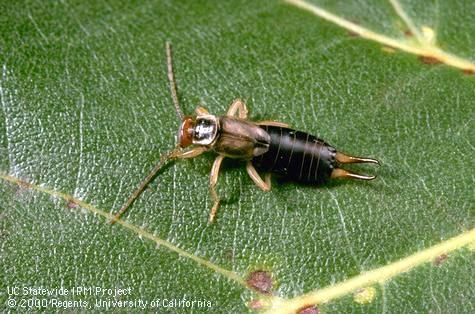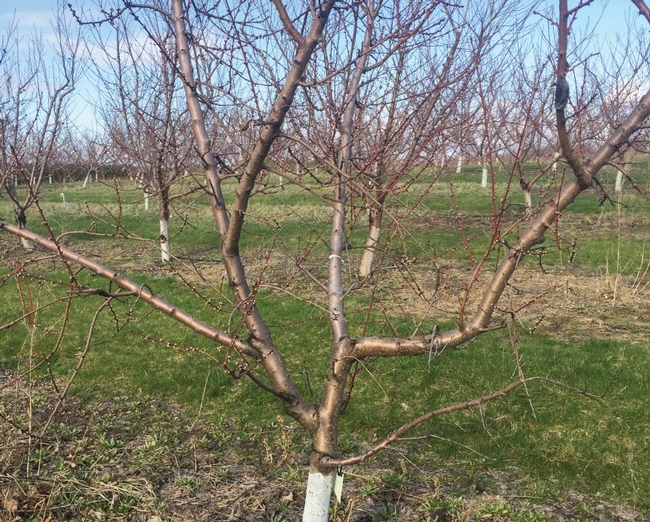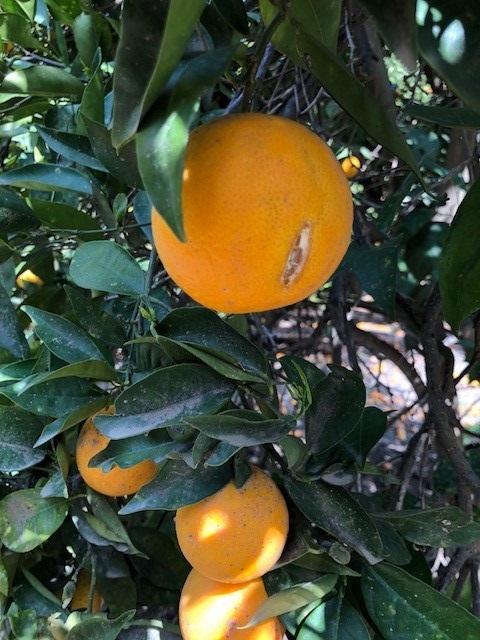
Posts Tagged: apple
Earwigs are Good?
It seems the humble earwig that can cause so much damage in citrus orchards in some years on some small trees can be a great boon in biocontrol. Read on:
WSU scientists unmask the humble earwig as an apple-protecting predator
By Seth Truscott,
College of Agricultural, Human, and Natural Resource Sciences
https://news.wsu.edu/2019/06/05/wsu-scientists-unmask-humble-earwig-apple-protecting-predator/
Helping Northwest apple growers protect their crops, WSU scientists have found new proof that earwigs are actually valuable predators in apple orchards, rather than the creepy, crawly, apple-damaging pests they're sometimes assumed to be.
In the May 2019 edition of the journal Biological Control, Robert Orpet, recent doctoral graduate at Washington State University's Tree Fruit Research and Extension Center, details findings from his multi-year effort to shed light on the European earwig and its role in combating a costly orchard pest.
“Earwigs will eat just about anything, but we've found that aphid pests are high on their menu,” Orpet said. “By dining on pests and reducing growers' need to spray insecticides, earwigs are unappreciated predators that have important benefits for agriculture.”
Shy, invasive omnivore
An invader in U.S. orchards and gardens, the European earwig was first found in Seattle in 1907, spreading across the continent soon after. With their wriggly bodies and scary-looking tail pincers, earwigs have always suffered from a bad reputation.
“Apple pickers don't like them, because they have a tendency to hide in apple clusters,” Orpet said. “Farmers often find them inside damaged fruit, and since earwigs feed mostly at night, it's hard to see what they feed on. “Some growers wonder if they cause damage themselves.”
Scientists like Orpet, however, have long suspected that earwigs are an important predator of aphid pests.
Apple trees covered in “snow”

Orpet came to the earwig through his research into the woolly apple aphid, a costly pest of Washington's $2.4 billion apple industry.
Gaining its name from their coat of cottony fibers, woolly apple aphids feed on the roots and branches of apple trees, stealing nutrients and water and causing galls, or abnormal growths. Infestations can decrease tree growth and keep fruit from developing, while the aphid's sticky honeydew secretions can bring on fungal infections.
About the size of a sesame seed, woolly apple aphids can amass in fluffy, meter-long colonies.
“In bad years, infestations make apple trees look like they're covered in snow,” Orpet said. “That's when growers really take notice.”
Growers have difficulty managing woolly aphids with insecticides, because there are few effective insecticides, and no organic ones, currently available. Well-known predators like ladybugs and lacewings could take a bite out of the woolly aphid population, but Orpet wanted to know if the earwig makes a difference.
Working with Jessica Goldberger, an agricultural sociologist at WSU's Department of Crop and Soil Sciences, Orpet interviewed 15 orchardists and managers in Washington state, gauging their opinions on the insect's role.
Most growers weren't sure whether earwigs make a real difference for their crops, and some thought of them as minor pests.
At the same time, Orpet was learning what earwigs are really up to in Washington orchards. Working with managers at four different commercial orchards, Orpet set about catching earwigs with cardboard traps.
Aphids: Earwigs' favorite food

Active at night, earwigs hide by day in tight spaces. Corrugated cardboard sheets are a perfect shelter, so he could easily shake them out and count them.
Sectioning off orchards, Orpet removed earwigs in some places, adding them at others. In every site, he counted woolly aphid colonies and checked for fruit damage.
“There was an obvious difference,” Orpet said. “There were fewer aphid colonies in places where I released earwigs.” He found no evidence that earwigs were causing damage themselves, but captured video footage of earwigs eating aphids and destroying their colonies.
Orpet also inspected the contents of trapped earwigs' digestive systems to see what they actually eat. He found that earwigs regularly dine on aphids, even when local aphid populations are small.
“Our results show that earwigs aren't pests, and actually improve biological control,” Orpet said. “Some farmers spray chemicals to knock down their populations, but this research shows they don't have to, and probably shouldn't.
“Growers can reduce pesticide use, save on chemicals and labor, and leave this misunderstood predator to do its beneficial work, protecting their apples from aphids,” he added.
Along with Orpet and Goldberger, co-authors include WSU entomology professors David Crowder and Vince Jones.
Their research was funded by the Washington Tree Fruit Research Commission, USDA's National Institute of Food and Agriculture, and the Western Sustainable Agriculture Research and Education Program.
Media contact:
- Robert Orpet, doctoral graduate, Department of Entomology, 847-337-4480, robert.orpet@wsu.edu

earwigs
What Winter? Not Cold Enough for Apricot, Too Warm for Valencia
So, there are peach trees right now that are flower-less and leaf-less. Wisteria which should have flowered in February is bare. The Royal apricot next door has no flower. The Lombardy poplars and birch in Oxnard don't have leaves. Spring is here, grass is growing, but many deciduous trees are still leafless and haven't flowered? What is going on?
Deciduous fruit trees and many landscape trees like poplar, birch, willow and sycamore, etc. must go through a dormant period each winter in preparation for producing fruit and leaves the following spring and summer. This rest period, also known as a chilling period, is directly related to winter temperatures. For many varieties of trees, the most efficient temperature for chilling is 45°F, with little additional chilling effect at temperatures below 32°F. Brief warm spells in winter have a negative effect — temperatures above 70°F for four or more hours offset any chilling that happened in the previous 24-36 hours.
Once chilling is complete, the trees prepare to wake up from dormancy and bud after a certain amount of warming takes place. The amount of required warming is cumulative, measured by counting the number of degrees each day above a threshold temperature, usually 40°F. This cumulative warming, combined with how well the tree met its chilling requirement over the winter, determines whether a tree buds early or late in the spring.
Tables and charts have been developed for different chilling requirements of fruit trees. The number of hours needed at or below 45°F varies with the type of tree:
- Peach: 400 to 1050 hours
- Apple: 800 to 1100 hours
- Cherry: 1000+ hours
But in coastal Southern California, those hours are never achieved. You need to go to Santa Ynez to get close to those hours. More typically in the Santa Paula, Santa Barbara, San Luis Obispo area, the chilling hours below 45 are close to 200 and lower in many years. Some years there is more, some years less. How temperatures above 70 affect chilling aren't always clear. As a result there are several different ways to account for chilling and none of them work very well for the coast./
Fortunately, we have low-chill varieties of many fruit trees that will produce with lower chilling. So ‘Anna' apple and ‘Royal' apricot do well, and many landscape trees are adapted to the lower winter chilling along the coast and do well. Low chill blueberries thrive to the point that in many years, they don't even go dormant.
This year the warm, cold, warm, cold pattern has mixed trees up. There are some deciduous trees that are doing fine, while others still have not flowered and leafed out. The mix of temperatures is not following the traditional patterns used to calculate chilling requirement. The trees are following their own pattern.
In the last several years in Southern California, winters have seemed shorter and milder, resulting in earlier springs. Trees that have flourished in a location could have decreasing yields in the future, and the favorable locations to grow these fruit trees could shift.
The Fruit and Nut Center at UC Davis has a link to the CIMIS system operated by the CA Dept of Water Resources. The site has various methods of calculating chilling hours, none of them seem adequate though for describing what is happening in the landscape today in Southern California
http://fruitsandnuts.ucdavis.edu/Weather_Services/chilling_accumulation_models/
Look at it to see if you can see a new way of understanding deciduous tree response to the weather.
Just got a call recently that 'Valencia' oranges are splitting. This normally happens to ripe 'Navels' that are over mature and get erratic winter irrigation, especially during drought. In this case, the 'Valencias' are advanced in maturity because of the warm winter, probably advanced by two months. Again erratic watering has probably lead to this splitting.
What a crazy winter.
Splitting coastal 'Valencia' oranges in April, 2018
photo: Peaches without adequate chilling.

no chill peach
Fruit and Nut Trees for Coastal California
It's possible to grown many other tree crops along the coast other than avocado and citrus. When speaking of other perennial evergreens like avocado, trees that don't lose their leaves but retain a canopy year round, we want trees that can handle the occasional cold periods that happen in winter. In fact, some trees like 'Hass' avocado need something like 50 hours of chilling – hours below 45 degree Fahrenheit. When trying to grow ‘Hass' in the tropics, the tree gradually loses vigor because the cold need to break dormancy of buds isn't there. So they grow tropical varieties in Florida and the Dominican Republic and consumers get used to the less oily flavor of the tropical varieties. Low or no chilling requirement fruit trees like durian, jackfruit and other tropical fruit can't handle the cold we get in coastal California. There are many different unusual fruits that can be grown, like cherimoya, sapote and mango throughout the southland.
However, if we try to grow low chill varieties of deciduous fruit that can handle winter cold, like apple and peach varieties, they often have insipid in flavor. Here's a list of fruit trees that are adapted to coastal southern California. And if you choose any of the deciduous varieties, make sure you plant them bare root next winter. They are cheaper and transplant better with less transplant shock than planting them when they are in leaf.
http://ceventura.ucanr.edu/Com_Ag/Subtropical/Fruit_and_Nut_Varieties/

peaches
Avocado Body Rots Are Showing Up Now
Get ready for more rotting avocado fruit if you have leaf blight showing up in your tree canopy. The fungal spores (one of the Botryosphaerias we once lumped as Dothiorella) that create the infection spread in an irregular pattern over the leaf and down the stem (then called “stem blight”). This is often confused with salt or tip burn. The two conditions are caused by the same problem, water and or salt stress. However, in the case of leaf blight, this is a pathogen that can pass to neighboring fruit and begin the process of rot. This starts happening when the fruit starts ripening and softening, so it's often not seen in the orchard, but the packhouse or in the market.
Control is basically gaining control over the soil moisture and salinity in the root zone and when the leaf blight starts showing up in the canopy, cutting as much out back to green tissue as is economically possible.
Leaf blights from this group of fungi have also been reported as infecting other fruits, such as citrus, apple, peach and grape among others. The solution is the same - water right and cut the stuff out when and if it shows up.
Photos:
Body rots
Rot spreading to flesh
Leaf Blight

avocado body rot1

avocado body rot2

Avocado leaf blight
Hops And Cider Workshop
|
X

Hopa

